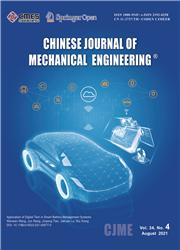Material Removal Mechanism and Force Modeling in Ultrasonic Vibration-Assisted Micro-Grinding Biological Bone
IF 4.5
2区 工程技术
Q1 Engineering
引用次数: 0
Abstract
Abstract Micro-grinding with a spherical grinding head has been deemed an indispensable method in high-risk surgeries, such as neurosurgery and spine surgery, where bone grinding has long been plagued by the technical bottleneck of mechanical stress-induced crack damage. In response to this challenge, the ultrasound-assisted biological bone micro-grinding novel process with a spherical grinding head has been proposed by researchers. Force modeling is a prerequisite for process parameter determination in orthopedic surgery, and the difficulty in establishing and accurately predicting bone micro-grinding force prediction models is due to the geometric distribution of abrasive grains and the dynamic changes in geometry and kinematics during the cutting process. In addressing these critical needs and technical problems, the shape and protrusion heights of the wear particle of the spherical grinding head were first studied, and the gradual rule of the contact arc length under the action of high-speed rotating ultrasonic vibration was proposed. Second, the mathematical model of the maximum thickness of undeformed chips under ultrasonic vibration of the spherical grinding head was established. Results showed that ultrasonic vibration can reduce the maximum thickness of undeformed chips and increase the range of ductile and bone meal removals, revealing the mechanism of reducing grinding force. Further, the dynamic grinding behavior of different layers of abrasive particles under different instantaneous interaction states was studied. Finally, a prediction model of micro-grinding force was established in accordance with the relationship between grinding force and cutting depth, revealing the mechanism of micro-grinding force transfer under ultrasonic vibration. The theoretical model’s average deviations are 10.37% in x -axis direction, 6.85% in y -axis direction, and 7.81% in z -axis direction compared with the experimental results. This study provides theoretical guidance and technical support for clinical bone micro-grinding.超声振动辅助微磨生物骨材料去除机理及力建模
在神经外科和脊柱外科等高风险手术中,骨磨削一直受到机械应力裂纹损伤的技术瓶颈困扰,球面磨头微磨削已被认为是不可缺少的一种方法。针对这一挑战,研究人员提出了一种基于球形磨头的超声辅助生物骨微磨削新工艺。力建模是骨科手术工艺参数确定的前提,而骨微磨削力预测模型的建立和准确预测的难点在于磨料颗粒的几何分布以及切削过程中几何和运动学的动态变化。针对这些关键需求和技术问题,首先对球面磨头磨损颗粒的形状和突出高度进行了研究,提出了高速旋转超声振动作用下接触弧长渐变规律。其次,建立了球面磨头超声振动下最大未变形切屑厚度的数学模型;结果表明:超声振动可以减小未变形切屑的最大厚度,增大塑性和骨粉去除范围,揭示了减小磨削力的机理;进一步研究了不同磨粒层在不同瞬时相互作用状态下的动态磨削行为。最后,根据磨削力与切削深度的关系,建立了微磨削力的预测模型,揭示了超声振动下微磨削力传递的机理。与实验结果相比,理论模型在x轴方向上的平均偏差为10.37%,y轴方向上的平均偏差为6.85%,z轴方向上的平均偏差为7.81%。本研究为临床骨微磨提供理论指导和技术支持。
本文章由计算机程序翻译,如有差异,请以英文原文为准。
求助全文
约1分钟内获得全文
求助全文
来源期刊

Chinese Journal of Mechanical Engineering
ENGINEERING, MECHANICAL-
CiteScore
5.60
自引率
4.80%
发文量
3097
审稿时长
8 months
期刊介绍:
Chinese Journal of Mechanical Engineering (CJME) was launched in 1988. It is a peer-reviewed journal under the govern of China Association for Science and Technology (CAST) and sponsored by Chinese Mechanical Engineering Society (CMES).
The publishing scopes of CJME follow with:
Mechanism and Robotics, including but not limited to
-- Innovative Mechanism Design
-- Mechanical Transmission
-- Robot Structure Design and Control
-- Applications for Robotics (e.g., Industrial Robot, Medical Robot, Service Robot…)
-- Tri-Co Robotics
Intelligent Manufacturing Technology, including but not limited to
-- Innovative Industrial Design
-- Intelligent Machining Process
-- Artificial Intelligence
-- Micro- and Nano-manufacturing
-- Material Increasing Manufacturing
-- Intelligent Monitoring Technology
-- Machine Fault Diagnostics and Prognostics
Advanced Transportation Equipment, including but not limited to
-- New Energy Vehicle Technology
-- Unmanned Vehicle
-- Advanced Rail Transportation
-- Intelligent Transport System
Ocean Engineering Equipment, including but not limited to
--Equipment for Deep-sea Exploration
-- Autonomous Underwater Vehicle
Smart Material, including but not limited to
--Special Metal Functional Materials
--Advanced Composite Materials
--Material Forming Technology.
 求助内容:
求助内容: 应助结果提醒方式:
应助结果提醒方式:


